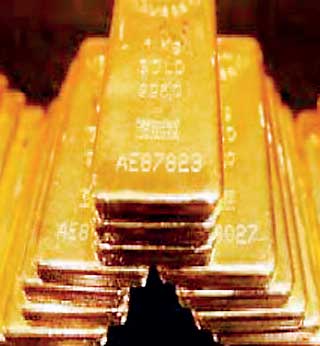Tuesday Dec 23, 2025
Tuesday Dec 23, 2025
Wednesday, 28 October 2015 00:00 - - {{hitsCtrl.values.hits}}
LONDON (Reuters): Surging demand for coins and bars and a rise in buying by central banks pushed physical gold demand up 7% in the third quarter, an industry report showed on Tuesday, though the market remained in a surplus of 51 tons.
Demand for gold coins and bars jumped by 26% year-on-year in the last quarter,  GFMS analysts at Thomson Reuters reported in the Q3 update of their Gold Survey 2015.
GFMS analysts at Thomson Reuters reported in the Q3 update of their Gold Survey 2015.
Retail investment surged in top consumers India, China and Germany, with buying rising 30%, 26% and 19% respectively. Those three markets alone accounted for an additional 26 tons of retail buying.
“A sharp price correction in July, which saw the gold price plunge to a near six-year low at the start of the quarter, was the major driver behind Q3 growth,” GFMS said.
Central bank purchases picked up speed in the third quarter after a quiet start to the year, rising 13% to 132 tons. Russia is expected to be this year’s biggest reported official-sector gold buyer.
Central banks are expected to become net buyers of gold for a sixth consecutive year in 2015, the report said.
Nonetheless, the group’s price view for this year remains cautious due to continued uncertainty over the timing of a rise in interest rates by the Federal Reserve, low inflation expectations, and weak investor sentiment.
“We expect gold to average $1,100 an ounce in Q4 2015, down by $75 an ounce from our previous forecast, which brings an annual average of $1,159 in 2015,” it said.
“Gold is set to remain under pressure until there is more clarity on the timing and the scale of U.S. rates normalisation.”
Gold prices held near $1,165 an ounce on Monday.
Jewellery fabrication, the biggest individual segment of demand, fell 1% in the third quarter to 510 tons. European jewellery consumption fell 23% on the back of plunging demand from Russia and Turkey.
Chinese jewellery demand edged up half a percent year-on-year, GFMS said, while Indian jewellery demand rose 5%.
India regained its position as the world’s biggest gold consumer from China in the first three quarters of the year, GFMS said, with overall consumption of 642 tons. Chinese consumption stood at 579 tons.
“We still expect China’s total gold demand to record a second consecutive annual decline in 2015,” GFMS said, though it added that it expected consumption to be stronger in the second half of the year than the first, and for Chinese demand to grow modestly next year.
On the supply side of the market, mine output was broadly flat year-on-year in the last quarter, while scrap supply rose 3% on strong gains in India and Turkey.